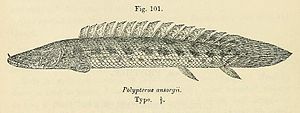Polypterus ansorgii
| Polypterus ansorgii | ||||||||||||
|---|---|---|---|---|---|---|---|---|---|---|---|---|

Polypterus ansorgii |
||||||||||||
| Systematics | ||||||||||||
|
||||||||||||
| Scientific name | ||||||||||||
| Polypterus ansorgii | ||||||||||||
| Boulenger , 1910 |
Polypterus ansorgii is an African freshwater fish from the family of pike fish (Polypteridae). The species has so far been found in the Rio Corubal in Guinea-Bissau, in the upper Niger riverbasinnear Kouroussa in Guinea and in the Kainji reservoir and in the Ogun in Nigeria.
features
Polypterus ansorgii becomes a maximum of 28 cm long. The elongated body, covered with ganoid scales arranged in oblique rows, is approximately round in cross section in the front two thirds. The last third of the body is flattened laterally. The fish are greenish-black in color and have large black spots on the sides of their bodies. The lower jaw of the fish is exactly as long as the upper jaw and does not protrude. Polypterus ansorgii has 55 to 62 scales in a row along the sideline , 42 to 46 scales in a row around the body, and 11 to 13 scales in front of the first raft. The lateral line scales of older specimens are notched on their rear edge. The number of dorsal flippers is 12 to 15. The anal fin is supported by 12 to 14 fin rays. The pectoral fins extend to the first raft.
Way of life
Like all pike fish, Polypterus ansorgii is a bottom-dwelling fish species that can also breathe air through the swim bladder that acts as a lung . It lives in rivers and swamps and feeds mainly on fish, as well as snails and crustaceans.
literature
- Frank Schäfer: Polypterus: Flösselhechte / Bichirs. Publisher: ACS, June 2004, ISBN 978-3936027396
- Suzuki, D., MC Brandley and M. Tokita, 2010. The mitochondrial phylogeny of an ancient lineage of ray-finned fishes (Polypteridae) with implications for the evolution of body elongation, pelvic fin loss, and craniofacial morphology in Osteichthyes. BMC Evolutionary Biology 10: 1-12.
Web links
- Polypterus ansorgii on Fishbase.org (English)